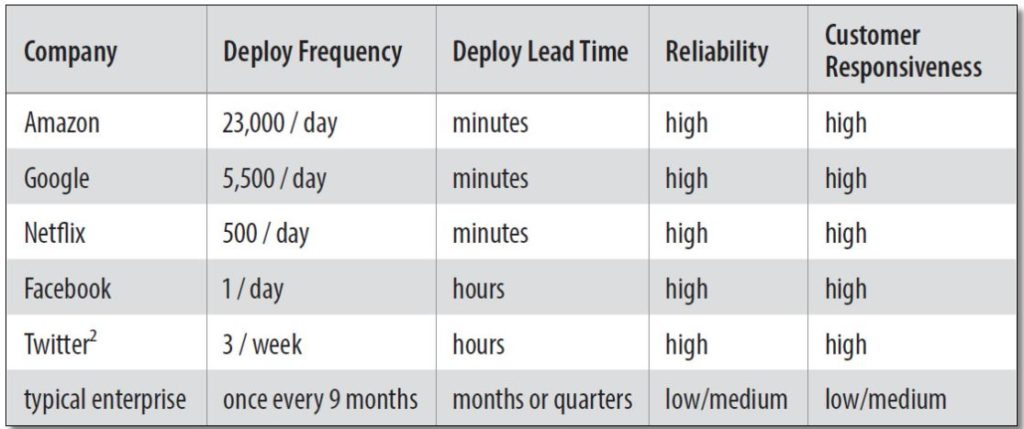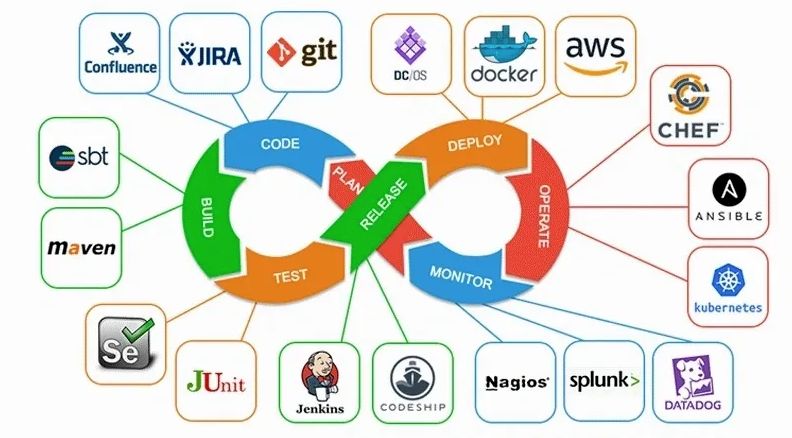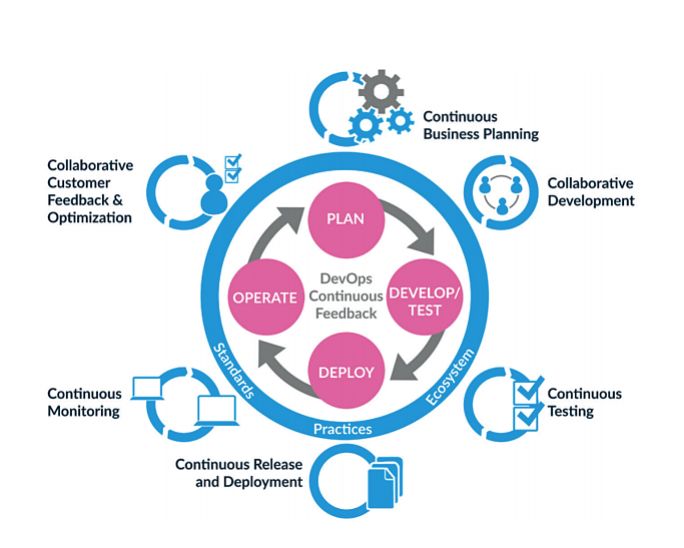Think of the most successful technology companies, and you’ll likely come up with the following names: Amazon. Google. Facebook. Twitter. Netflix. What do they all have in common? It’s not big pockets (well, at least not when they were starting out). Instead, it’s that they all release improved versions of their products, all the time.
In fact, some of these enterprises release thousands of subtle improvements to their existing code up to tens of thousands of times a day.

Image: O’Reilly
At these kinds of deployment rates, it’s no wonder that users can never seem to get enough of them. There’s almost always some new trick or feature that users can take advantage of. Compare Amazon’s intense deployment frequency to the average enterprise, and it’s easy to see how competitors that wait even a few months before releasing a significant update tend to fall behind these trailblazers.
How are deployment schedules like these even possible, particularly when you rarely hear rumors that Google, Amazon, or Twitter are experiencing updates issues?
Two words: DevOps architecture.
What is DevOps Architecture?
Contrary to architecture references in computing today, DevOps is not a framework for building computing systems. DevOps is more a mindset, a culture, and a philosophy that emphasizes collaboration, communication, and continuous improvement as a means of rapidly and sustainably releasing better software in the most efficient way possible.
DevOps seeks to encourage the entire organization to take part in delivering regular, incremental improvements to their software applications.
In this way, DevOps takes inspiration from Agile development. Nonetheless, it is an improvement over both Agile and Waterfall development, where developers complete an entire project before handing it over to operations for testing in production.
Developers and operations specialists used to work in silos. Devs focused on writing code, while operators took on the sysadmin role, running the code in production environments.
Yet, because of breakdowns in communication and closed collaborations, things that should be straightforward—such as ensuring customers’ requests were passed on to developers and operational staff received clean code—became challenging.
Unfortunately, all of this still happens in organizations that have yet to implement or reap the benefits of DevOps.
DevOps starts with developers, operators, and quality assurance. However, it also involves everyone within an organization, since it reduces time-to-market, time-to-benefits, and quality-to-market for the entire organization.
In DevOps, the right people, using the right tools, rigorously test software updates before releasing them to users. Several key DevOps principles make this possible.
DevOps Principles: What are the Features of DevOps?
Here are the four DevOps features that guide all stakeholders:
Collaboration
DevOps enables continuous communication between cross-functional and autonomous teams. Also, DevOps advocates for getting customer feedback early on during sprints to help inform expectations, thus guiding developers on what features to focus on to minimize revisions.
This principle also promotes end-to-end responsibility by ensuring that each DevOps architect knows their role and works toward supporting efficient implementations across the entire DevOps pipeline.
Automation
When you automate processes, you eliminate resource waste, excess effort, and unnecessary fiddling. Fortunately, it’s possible to automate many aspects of workflow, testing, and deployment. This reduces human error, saves time, and frees engineers to keep innovating.
Teams can use a variety of automation tools for specific tasks:

Image: Smarchy
Iteration
The DevOps approach aims to facilitate rapid releases and encourages frequently committing code to a version control repository such as GitHub or BitBucket.
Should the build not pass testing, revision control allows engineers to revert to a working version of the code. Otherwise, an automation tool or engineer rapidly pushes code that passes a quality check into production.
A microservices architecture provides this flexibility, as different engineering teams can update various parts of an app simultaneously without affecting the rest of the app. This is the opposite of a monolithic architecture, which is hard to modify without affecting the entire application.
Continuous Improvement
DevOps thrives on incremental improvements derived from real-time user feedback, technology changes, use cases, and other sources. As you’ll see in the section below on DevOps components, this is a continuous process based on CI/CD principles.
What Does the DevOps Workflow Look Like?
Most organizations will have a DevOps workflow that looks something like this:

Image: Leanix
Here is a breakdown of the different DevOps process flow at play here.
1. Continuous Planning
This is where teams and stakeholders from other departments identify what features need to be improved, look at prioritization, track progress visually (often using the agile method), and analyze opportunities and risks to figure out how to proceed.
This step in the process also introduces customer requirements so that Devs, Ops, and QAs can utilize them for continuous improvement.
2. Continuous Integration (Collaborative Development)
Continuous integration (CI) involves merging code from multiple development teams into one source code repository. All code changes are automatically tested to ensure all developers have access to valid and current code at all times.
In waterfall development, teams must wait for one team to complete a major update before doing their part, which slows releases.
3. Continuous Testing
Testing involves verifying that the code works and meets customer requirements as intended by the developers. The team uses automated tools to catch bugs faster to speed up the process.
4. Continuous Delivery
Continuous delivery (CD) involves building, testing, and packaging approved code for release into a production environment. CD enables rapid releases while ensuring tight security.
5. Continuous Deployment
Continuous delivery and continuous deployment are similar concepts; however, the former uses automation for almost everything and is especially ideal for teams who have had some success practicing CI/CD.
Continuous deployment is the ultimate goal of DevOps, since automating most processes increases efficiency.
6. Continuous Monitoring and Communication
Monitoring isn’t just the last step in the DevOps process flow. Teams should be monitoring their workflows all of the time in order to catch bugs before releasing the code to production.
DevOps engineers use various tools that increase observability of the way architecture components work over time to tackle issues that elude manual and automated testing processes. These tools detect and report anomalies automatically, so that teams can correct the code before users encounter issues.
What Next?
DevOps requires a change of mindset, procedures, and culture in an organization. It also aims to nurture DevOps engineers who can foster continuous improvement.
Developers, operators, and quality assurance engineers set the culture in motion. Still, many other specialists are also instrumental, such as the DevOps architect, the build engineer, the database engineer, the automation engineer, and the project manager.
But how do you go about using the proper DevOps tools when you don’t have the right people on-staff, skills, and insider knowledge? Simpat Tech can help.
Our team includes vetted DevOps experts with proven experience who can help you set up and optimize your DevOps architecture and workflows. Talk to us today to see how.
